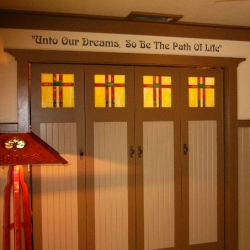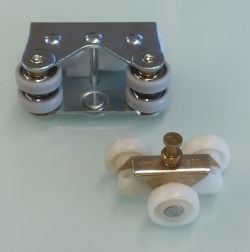Posts Tagged ‘door hardware’
What are the differences between Interior Doors and Closet Doors?
We often receive emails and phone calls asking us which doors can be used as closet doors and which can be used for interior doors between rooms. Many people are concerned that there may be some reason why the same door should not be used in both places.
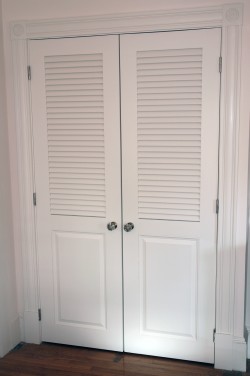
Hinged doors with wider stiles to hold knobs
Door Designs
The truth is that all Kestrel designs of closet doors and interior doors are interchangeable. This means that you can have your interior doors match your closet doors throughout your home. Something to keep in mind, however, is that some designs may be more practical for certain types of rooms or closets. Operable and Fixed Louvered Doors for ventilation. False Louver, Tongue & Groove and Panel Doors for sound insulation. Glass and Mirrored doors to help brighten dark rooms. There are also doors that combine designs to offer a bit of each.
Door Thickness and Stile Width
The stiles of a door (not “style”) are the vertical frame parts of the door. On interior doors between rooms it is not uncommon to see wider and thicker stiles. This is because most locks and door knobs require a hole drilled right through the door. The thicker door and wider stiles allow this while keeping the door itself structurally sound. On closet doors the overall thickness and stiles can be narrower since locks and handles are not usually required.
Door Hardware
There are 4 basic types of hardware for doors. Hinged doors, pocket doors, bifold doors and sliding doors. With closet doors all 4 types of hardware are used consistently depending really only on how you plan to use the closet. While with interior doors we normally see hinges it is still common to use bifold, sliding and even pocket door hardware used. Below are two good examples.
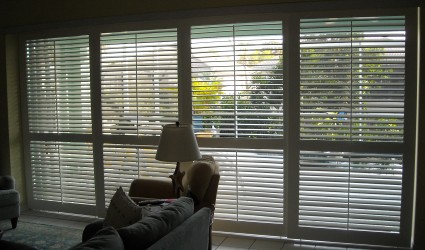 Operable Louvered Doors use sliding door hardware to close off a lanai. |
If you are not sure which door designs and options will work best for you please ask us. Give us a call, send us an email or start an online chat. We are happy to help.
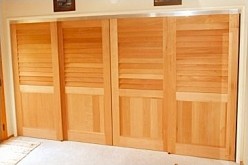
Spanish Cedar Sliding Closet Doors
Track Hardware for Sliding Closet Doors
When it comes to choosing track hardware for your sliding closet doors the main decision is really about how many individual doors do you want on each track. Your options vary somewhat depending on whether you are going with 2, 3 or 4 sliding doors to cover your closet.
Applications with 2 Sliding Closet Doors
If you have 2 doors covering your closet then you have a choice of a 2 track system or a wall mount system. With the standard 2 track system (figure 1) the doors slide back and forth within the opening so you can access half of your closet at any one time. With the wall mount (figure 2) you have full access to the closet however you need to have clear wall space for the doors to slide.

figure 1: Sliding Door Hardware - 2 Doors on 2 Tracks

figure 2: Sliding Door Hardware - 2 Doors on 1 Wall Mounted Track
Applications with 3 Sliding Closet Doors
With 3 doors covering your closet you can choose either a 2 track or 3 track system. With the 2 track system (figure 3) you will have 1 door on 1 track and 2 doors on the other track. This means that you can only open up one third of your closet at any time. With the 3 track system (figure 4) each door has its own track so that you can slide and stack all 3 doors one behind the other. This allows you access to two thirds of the closet. Something to keep in mind is that if you go with a 3 track system you need to have enough depth in your header to hold all 3 doors. A standard wall built with 2x4s and a 4.1/2″+ jamb header is deep enough to accommodate 3 doors 1.1/4″ or 1.3/8″ thick. If you are using 1.3/4″ doors you will need a jamb header at least 5.1/2″ deep.

figure 3: Sliding Door Hardware - 3 Doors on 2 Tracks

figure 4: Sliding Door Hardware - 3 Doors on 3 Tracks
Applications with 4 Sliding Closet Doors
For 4 doors the most common layout that we see is a 2 track system (figure 5) with 2 doors on each track. This allows for half of the closet to be open at a time. The alternative is to have each door on its own track (figure 6). This would give you the most access to your closet however you will need to have walls built with 2×6 studs as a minimum.

figure 5: Sliding Door Hardware - 4 Doors on 2 Tracks

figure 6: Sliding Door Hardware - 4 Doors on 4 Tracks
Do you need a Bottom Track?
The commercial grade sliding door hardware that we offer is designed so that all of the weight is supported at the top. This means that a bottom track is used only to guide the doors and keep them from swinging front to back. On the standard 2 track system the bottom track is optional. You would really only need the bottom track if you are concerned about the doors being pushed front to back like you might have in certain commercial applications or if you had large pets. On sliding closet doors systems with 3 or more tracks a bottom guide track is already included.
Which Track Hardware is best for your Sliding Closet Doors?
What I always recommend to people when they are deciding on their track hardware is this. Stand in front of your closet and imagine how you will be using your closet. If you will only be using part of the closet at any one time then a 2 track system will probably work for you. If you prefer to have the closet open as much as possible while you look over everything and make a decision then having each door on its own track will be better for you. What it really comes down to is “which do you prefer?”
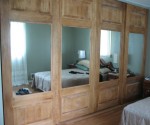
Sliding Closet Doors w/ Removable Mirrors
If you are still not sure which sliding closet door hardware will work for you let us help. Give us a call, send us an email or start an online chat. We are happy to help.
 A common misconception is that closet door hardware, especially hardware for sliding closet doors, requires a bottom track. The belief is that the bottom track helps support the weight of the doors as well as keep the doors aligned.
A common misconception is that closet door hardware, especially hardware for sliding closet doors, requires a bottom track. The belief is that the bottom track helps support the weight of the doors as well as keep the doors aligned.
The Johnson Hardware, that we supply with our closet doors, is actually designed the other way around. The top track rollers (shown at right) can support doors up to 200 lbs each for medium rated (3 wheels) and 400 lbs each for the heavy duty rated (4 wheels). This means that, since the top track supports all of the weight, the optional bottom track is used only to help guide your sliding closet doors and bifold doors.
When should I use a bottom track?
You really only need to use the bottom guide when there is a concern that the doors might be bumped hard enough to swing, front to back. Some good examples would be if the doors are being be used between rooms or if you have small children or large pets.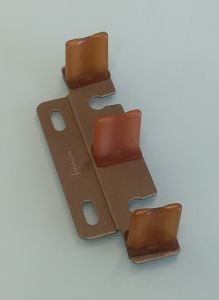 If you have only 2 rows of closet doors in the opening (1 or 2 doors in the front row and 1 or 2 doors in the back row) there is a simple floor guide (shown at left) that keeps the doors separated and from hitting each other. If you look closely at the top picture, you will see these guides where the front row doors overlap the back row doors. (a close-up is shown in the image to the right)
If you have only 2 rows of closet doors in the opening (1 or 2 doors in the front row and 1 or 2 doors in the back row) there is a simple floor guide (shown at left) that keeps the doors separated and from hitting each other. If you look closely at the top picture, you will see these guides where the front row doors overlap the back row doors. (a close-up is shown in the image to the right) 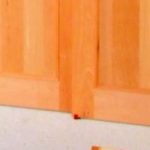 If you have doors in 3 or more rows, then bottom guide tracks are required.
If you have doors in 3 or more rows, then bottom guide tracks are required.
Are bottom tracks only for sliding closet doors?
No. Larger bi-fold doors are also good candidates for a bottom guide track. Follow the same rule as with your sliding closet doors. If you think your bi-fold doors are going to be bumped a lot then a bottom guide track might be helpful.
Do I need to cut into my floor to install the bottom track?
No. Since the bottom guide tracks do not support any weight they can be surface mounted to your floor. Wood strips can be placed on either side of the track to give the look of a finished threshold. If you have not installed your floor you can also use a bottom guide track. In this case you would simply install your flooring on either side of the bottom guide track. The nice thing about this method is that the track is submerged below the floor level so there is no concern about tripping.
So while a bottom track is not needed to support the weight or your doors, it can help to guide your doors.
*This post was updated on December 24th, 2019

A naturally beautiful and renewable choice – Wood shutters and doors by
Kestrel Shutters & Doors, Inc. www.DIYShutters.com 1-800-494-4321 / sales@diyshutters.com
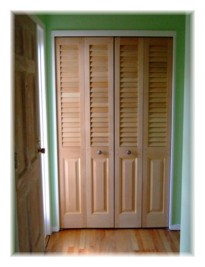 When it comes to closet doors, one of the most popular ways to mount them is as bifold doors. Basically this means that the doors are hinged together in pairs and will open and close in pairs.
When it comes to closet doors, one of the most popular ways to mount them is as bifold doors. Basically this means that the doors are hinged together in pairs and will open and close in pairs.
While there doesn’t seem like there would be much variation in the hardware for bifold doors there are a few different factors to consider.
Where will your doors fold open?
The first thing to look at is how you want to have your doors fold open. Traditional bifold doors will fold up in pairs within the closet opening. The doors can be mounted so that they all fold to one side only or split up so that pairs of doors fold to both sides. If you do NOT want the doors to fold up inside the opening then you can choose what is known as “full access” hardware.
Johnson Hardware 1601 series is a full access hardware that folds the doors 180° open and out against the face of the wall. The advantage of this is that you do not have pairs of doors blocking part of your opening. Three of the most practical applications for this are closets that hold a washer and dryer, closets that hold a home office and closets that stow away a Murphy Bed. If you do not have the wall space for your bifold doors to swing out and open then you will need to go with more traditional hardware that keeps the doors within the opening.
Can you mount your bifold doors to the floor?
Some hardware for bifold doors require that you mount a bottom pivot directly on to your floor. If you have custom flooring this may not be practical or desired. This is one of the reasons that Johnson Hardware 111FD series is so popular. This is a heavy duty track hardware that holds bifold doors up to 50 lbs each but does not require you to touch your floor. Instead the bottom pivot mounts to your jamb to support your bifold doors.
Are your closet doors oversized?
Many of the closet doors we make are oversized and need to have bifold door hardware that has heavier limits. The Johnson Hardware 100FD series will handle bifold doors up to 75 lbs each and the Johnson Hardware 200FD series will handle bifold doors up to 48″ wide each and 125 lbs each. These series of bifold track hardware will have a bottom pivot that mounts to the floor to help stabilize the oversized doors.
Closets with more than 4 doors
Sometimes it makes sense to have more than 4 doors within a closet opening. Most often it is because the closet has a very wide opening or it could even be several sets of interior doors to separate two rooms. In cases like this we offer what is referred to as multifold door hardware. The Johnson Hardware 100RD series will handle doors up to 24″ wide and 50 lbs each while the Johnson Hardware 200RD series will handle doors up to 36″ wide and 75 lbs each. Both of these can handle up to a maximum of 12 individual interior doors, 6 folding to the left and 6 folding to the right.
Bifold Door Hardware – Summary Table
| Series | max. Door Size | max. Door Weight | max. Doors Folding in One Direction | Bottom Pivot |
| 1601 | 24″ x 96″ | 30 lbs. | 2 | none |
| 111FD | 24″ x 108″ | 50 lbs. | 2 | Jamb Mount |
| 100FD | 24″ x 108″ | 75 lbs. | 2 | Floor Mount |
| 200FD | 48″ x 108″ | 125 lbs. | 2 | Floor Mount |
| 100RD | 24″ x 108″ | 50 lbs. | 6 | Floor Mount |
| 200RD | 36″ x 108″ | 75 lbs. | 6 | Floor Mount |

A naturally beautiful and renewable choice – Wood shutters and doors by
